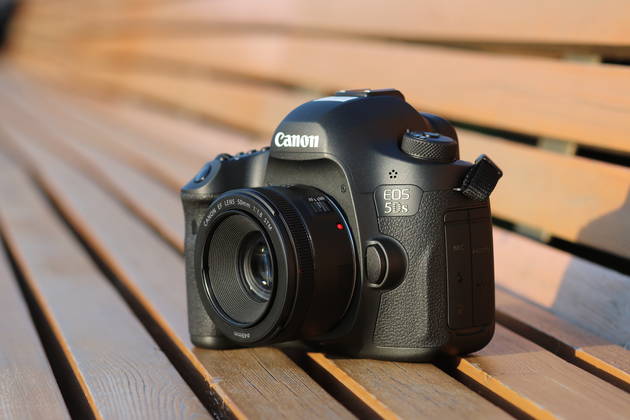Lens overview
Today we have a test lens that promises to be a real bestseller. Why? Well, let's start with the fact that this is a high-speed “fifty dollars”, which equally suits both full-frame and full-frame Canon mirrors. Its cost is really low, when compared with any other fast aperture. Finally, it’s enough to recall the popularity of his predecessor, who has invariably accompanied any enthusiastic “canonist” over the past two decades. So, we meet the Canon EF 50mm f / 1.8 STM!
Canon EOS 5Ds and Canon EF 50mm F1.8 STM
Canon EOS 750D / Canon EF 50mm f / 1.8 STM Settings: ISO 100, F1.8, 1/1600 s
Design
The Canon EF 50mm f / 1.8 STM is an updated, albeit outwardly slightly similar to its predecessor version of the legendary Plastic Fantastic. Of course, you should not expect a metal case from budget optics. It is still made of polymer materials. But the mount became metallic - a trifle, but nice! About the changes in the autofocus system says the name of the lens. The letters STM indicate the use of a stepper autofocus drive adapted for movie shooting. At this point it is worthwhile to dwell in more detail. The key difference of the STM-drive is the ability to move the lenses at different speeds: when photographing quickly, and when shooting movies slowly, smoothly.Canon EOS 750D / Canon EF 50mm f / 1.8 STM Settings: ISO 100, F1.8, 1/3200 s
Autofocus cannot be called completely silent: in the process, it still emits a barely audible hum. You can also hear it with manual focusing: depending on the speed of rotation of the focusing ring, the sound frequency varies markedly. After all, the autofocus ring is electronic. Rotating it, you control all the same STM-drive autofocus. But the reaction of the electronics is so fast and accurate that the absence of direct contact with the focusing mechanism is absolutely not felt. There are no problems with manual focusing: sharpness can be brought with precision accuracy.
There have been other changes to the lens design. If the predecessor had only five aperture blades, the Canon EF 50mm f / 1.8 STM had seven. Due to this, when shooting on a covered diaphragm in the bokeh zone, flares in the form of nuts do not form, they remain round. This diaphragm is called rounded. As a rule, a rounded aperture is used in portrait lenses to obtain the softest blurring of the background, without distracting elements. Let's not forget that on cameras with an APS-C format sensor, the Canon EF 50mm f / 1.8 STM lens just becomes a portrait.
Rounded aperture
Canon EOS 750D / EF50mm f / 1.8 STM Settings: ISO 100, F1.8, 1/1600 s
Canon EOS 750D / EF50mm f / 1.8 STM Settings: ISO 100, F2, 1/1600 s
Canon EOS 750D / EF50mm f / 1.8 STM Settings: ISO 100, F2.8, 1/800 s
Canon EOS 750D / EF50mm f / 1.8 STM Settings: ISO 100, F4, 1/400 s
Canon EOS 750D / EF50mm f / 1.8 STM Settings: ISO 100, F5.6, 1/200 s
Canon EOS 5D Mark III / Canon EF 50mm f / 1.8 STM Settings: ISO 100, F2.8, 1/1600 s
The minimum focusing distance of the Canon EF 50mm f / 1.8 STM is 35 cm from the plane of the matrix. Of course, this is not enough for full macro shooting. However, large-scale shooting of flowers, even such small ones as lilies of the valley, will not be a problem.
Shooting from a minimum distance.
The picture was not taken with a serial camera.
Canon EOS 5DS / Canon EF 50mm f / 1.8 STM Settings: ISO 100, F1.8, 1/1600 s
Minimum Shooting


